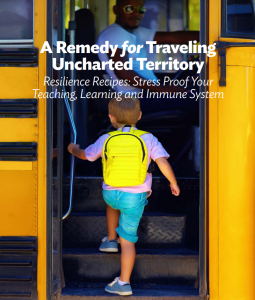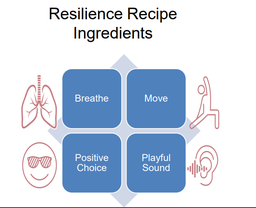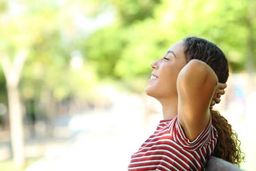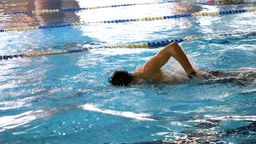A Remedy for Traveling Uncharted Territory
Resilience Recipes: Stress Proof Your Teaching, Learning and Immune System
By Sharon Montes, MD, FAIS
*This is an article from the Fall 2021 issue of Contentment Magazine.
In times of change learners inherit the earth; while the learned find themselves beautifully equipped to deal with a world that no longer exists. — Eric Hoffer
In times of change how do we all continue to be successful learners? How do we develop the reserve of resilience that allows us to recover from past stress, be present in the current moment and have the capacity to engage in future learning with curiosity rather than dread?
We are starting another school year. Stores are filled with shelves of notebooks and bins of glue and pencils. This year the usually joyful annual ceremony of back to school sales is clouded by our memories of last year. Last year people all over the world were faced with multiple challenges of how we create safety for self and others and adapt to change in all areas of life. We had to adapt to online learning; adapt to the merging of living, working, and teaching and learning spaces; adapt to the mixture of increased work and increased social isolation. Meeting these challenges provided different learnings for each of us. While we adapted, we emerged stronger, though many of us with a bit of fatigue from all that adapting.
As we enter this school year, I see and hear the wave of uncertainty that continues to color our conversations. How can we look at the unfolding of the next few months? There is no return to normal. How do we prepare to succeed as learners of all ages? The literature on stress teaches that it is not stress itself that has negative health effects but the story we tell about stress. In 2012 Keller published the results of an 8-year study that followed 30,000 American adults. His research showed that people who believed that “stress is harmful to health” had a 43% higher death rate.1 Woven in with all this is the idea that not only do we need to manage our stress to be better teachers, but that managing our stress also helps us improve our immune system.
I believe that we are entering uncharted territory. I remember the maps inside the front cover of those science fiction and Tolkien books from my adolescence. The mapping with names and images of the known world contrasted with the unexplored world labeled, “the sea of mystery,” filled with images of dragons.
As we prepare for the start of another school year entering this sea of mystery or uncharted territory, what are the learnings we can take from last year that we can apply to this new school year? How can we ride those dragons into creating safe space for ourselves and those we serve? Or more pragmatically, how can we defrag and reboot our nervous systems to prepare to be at our best to learn and teach. Learning happens best when we feel safe at the cellular level. We create that safety by blending body-mind-body practices.
In the Summer 2021 issue of Contentment Magazine,2 we introduced the concept of Resilience Recipes These recipes blend activities (ingredients) that nourish our vagus nerve to help us feel safe and centered at the cellular level. These activities also work to calm our adrenal glands, so we produce less stress hormones and also stimulate the part of our brain that produces oxytocin aka nature’s antidote to stress hormones. Setting up our body — our physiology — to learn, starts with the resilience recipe ingredients of integrating breath, integrative movement, mindfulness, and playful sound/positive choice.

Intentional Breath
“Breath is the bridge which connects life to consciousness, which unites your body to your thoughts. Whenever your mind becomes scattered, use your breath as the means to take hold of your mind again.”
― Thich Nhat Hanh, The Miracle of Mindfulness: An Introduction to the Practice of Meditation3
When teaching people to use breath to return to center and safety at a cellular level, we use a 4-step process. Sometimes when people have accumulated trauma at a cellular level, they may have baseline patterns of shallow rapid breathing. Asking them to change that pattern to promote relaxation can lead to temporary increase in stress. So before asking them to slow down or deepen their breathing we ask them just to notice and count their breaths.
Breathing techniques that activate the messages of: “I am safe. I am relaxed. I am ready to learn” include:
1. Drawing awareness to here and now with each breath in the body by counting your breath. The goal is to be able to count 12 breaths without your mind wandering to the past or future. Notice when your attention wanders, and each day gradually improve focus to achieve the ability to stay present until you have counted 12 continued breaths. I find it useful to use my fingers to help me stay focused during counting.
2. Increase the duration of exhale compared to inhale during each breath. This nourishes the vagus nerve that sends message from head to bottom of belly that we are safe and can relax.
3. Time your breath cycle to last 10 seconds from inhale to exhale. This rhythm, called resonant breathing, harmonizes and balances our breathing, heart rate, and nervous system. A balanced, alert, and calm nervous system helps our brain to be more receptive to learning.
4. Abdominal or diaphragmatic breathing — by expanding our abdomen when we inhale and pulling the belly towards the spine when we exhale, we allow downward movement of the diaphragm. This not only allows for more oxygen exchange, but it also promotes relaxation.
(Science note: By activating the receptors at the bottom part of our lungs when we breathe, we activate the parasympathetic (rest and relax) part of our nervous system. When we breathe using mainly the upper part of our lung, it activates more of the sympathetic (flight/fight) nervous system — kind of a body-mind-body catch 22. When we are stressed, our breathing patterns can create greater sensations and emotions of stress and continue to promote stress responses. This is where using the brain to consciously choose to take three slow deep breaths allows us to interrupt the cycle and create another body-mind-body feedback loop.)
The repetition of intentional breathing several times throughout the day creates new pathways that support our ability to stay calm in body and mind. Anchor these breath practices on an object or action so you do them at least five times/day. For example, notice your breath when you walk through a door; when the phone rings; when you look at or touch a ring, bracelet or watch; when you rub your ear; when you go to the bathroom. Even a mini break of three intentional breaths repeated through the day builds your “choice” muscle, making it easier to choose calm.
Integrated Movement
“Get out of your head and get into your body. Think less and feel more.” — Osho
Stress can get stuck in our bodies, especially in our nervous system and in our fascia. (Fascia is the white fibrous tissue that scaffolds, surrounds and connects our muscles, nerve fibers and organs. When we are stressed it contracts and the tissue and organs it surrounds and supports contract too.)
Certain types of movement have the ability to help us release this accumulated physical stress and create a calm alert brain. When we move our body, we send signals that activate our brain — changing the electrical and chemical messages. When we move different parts of our body in different directions, we activate different parts of our brain. When we add rhythm and mindfulness, we create an active, integrated brain that is ready to learn.
Integrated movement involves a combination of different movements:
1. Moving in all three dimensions in space — up and down, side to side, and front to back. Think of different movements as activating different areas in your brain. For example, when you move the right arm it causes electrical and chemical changes in the left side of your brain. Moving your left arm causes electrical and chemical changes in the right side of your brain.
2. Crossing midline — The easiest midline to imagine is the line running down the front of your body dividing the right and left sides of your body. You can cross this midline with your eyes; head — bending it from side to side; arms and legs. Think of this as integrating and pulling together the action on different sides of your brain.
3. Adding some rhythm and balance (repetition, shifting weight from side to side, front to back) pulls in the activity from another part of the brain which helps sharpen and integrate our senses for learning.
Examples of integrated movement include; walking, dancing, swimming, gardening, some forms of yoga and qigong.
Additional integrative movement include:
1. Hand to Knee Cross: do this seated or standing. Start slowly to coordinate the movements. Your right hand/palm crosses your body to touch your left knee. Then your left hand/palm crosses your body to touch your right knee. If seated gently lift the knee to meet the hand — to degree of comfort. If standing you can march or dance as you alternate sides crossing hand to knee. Then add the rhythm 1-2 1-2-3 bringing opposite hand to opposite knee to the rhythm of, “Ha, Ha, Ho, Ho, Ho.”
2. Nose to Ear: Hold your right ear with your left hand while you touch your nose with your right hand, then change hand positions and bring your right hand to your left ear and your left hand to your nose. Try to do this in synchronicity as you chant, “Ho, Ho, Ha, Ha, Ha.” Slowly increase the speed. Try it with your eyes closed.
Mindfulness and Positive Choice
Mindfulness isn’t difficult; we just need to remember to do it. — Sharon Salzberg
Mindfulness consists of two main techniques.
1. Observing our sensations, emotions and thoughts. Our thoughts bounce from past to future attached to emotions. Frequently worry or fear when our mind travels to the future and regret or anger when our thoughts travel to the past. By cultivating the awareness that we are not our sensations, emotions or thoughts, we have greater ability to be present here and now.
2. Naming — by naming our sensations and emotions we activate a different part of our brain. We are wired to react out of the part of our brain that is focused on survival and defending ourselves. With mindfulness and practice we can strengthen the pathways that act from wisdom and connection.
When we observe and label our sensations and emotions, we also notice that our sensations, emotions and thoughts are transient. The observer part of us allows us to reframe and create new meaning. Am I excited or afraid? It is the same inner chemistry with different meaning with different long-term health effects. Crum and colleagues recently described using mindfulness and some other self-regulation techniques to help people shift their perspective of stress from being bad to “it can be good for me.” With this change in perspective the stress responses can be changed to help achieve a goal.4
Mindfulness allows us to sit with “reality” as it is accepting the flow of sensations, emotions, and thoughts. While positive choice allows us to accept and reframe, to use our capacity for words, to create stories large enough for everyone to live and grow in. Many years ago, my acupuncturist asked me two questions that forever changed how I used my words to describe life events.5 (Video discussion link below.)
One example of using mindfulness and positive choice, as well as playful sound, is a classic laughter therapy exercise that was taught by Dr Annette Goodheart, author of Laughter Therapy.6
Health in Your Hands: Consider something you are dealing with that leads to contraction — physical; mental; emotional. As you call to mind this challenge, notice where it is in your body sensation — aware of a feeling in your body. Place that issue in the palm of your hand. Now bring that hand with the palm facing your face up close to your face. Plaster your palm against your nose so that all you can see is your hand. Now as you breathe add a gentle laugh to your exhale. With each exhale slowly allow your hand to move away from your face. Notice how your awareness changes. What do you see? Any change in body sensation?
Another positive choice exercise is:
Gratitude for Be Here Now:
1. Thank yourself
2. Thank person either side of you
3. Thank all that is around you — air, earth, chairs, tables
With choice, breath, movement, and gratitude our perspective and awareness can expand.
Playful Sound
“Sometimes your joy is the source of your smile, but sometimes your smile can be the source of your joy.” — Thich Nhat Hanh
This is the Resilience Recipe ingredient that most adults find quite challenging to integrate on a regular basis. While many people have a regular gratitude practice, they don’t have a regular laughter practice. Though some people rely on humor, movies, tickling, and jokes to get their dose of laughter, there are real health benefits from just choosing to laugh because you can. Laughter yoga and laughter wellness clubs and events provide a safe space in-person and online for people to laugh on a regular basis.
One easy way of getting laughter sounds into your life is to use LA-LA-LA lyrics to any song. This sound to music — lifts the palate, nourishes your vagus nerve, and activates both sides of your brain. I use one of my favorite variations of this exercise when my dad has a fit of grumpy mood. I will sing Joyful, Joyful, We Adore Thee by Henry J van Dyke, using a loud deep BAA-BAA-BAA –BAA sound. It doesn’t always improve his mood, but it definitely helps me feel happier.
Other laughter exercises to play with:
1. Cry and Laugh: Cry as you lean forward, laugh as you stand back up. Repeat a few times. Or alternate
2. Anger / Laughter / Choice: using gibberish, express anger with a partner. Then move into laughing, knowing you have choices about being angry. If doing this alone, be angry with your reflection in front of a mirror, and then break into laughter.
3. Gift of Laughter: Hold the gift of laughter in your hands. It is a present that you choose to give yourself. Where and when do you receive it? Practice sharing and receiving laughter with others in a group.
Conclusion:
As a community we can explore the uncharted territory of this new school year using curiosity and a commitment to using our always accessible tools of breath, movement, and the ability to reframe. Let’s use our beautiful brains and bodies to prepare us to be ready to learn and have strong immune systems. We blend the wisdom of health traditions that have helped humans adapt to stress for thousands of years with the science that shows us that “Individuals who appraise stress as challenging, as opposed to threatening, and hold beliefs that stress can be enhancing and facilitate pursuit of valued goals, as opposed to debilitating and suboptimal in goal pursuit, cope more effectively and exhibit better outcomes.”7 By combining breath, movement, mindfulness, and positive sound throughout the day, we create the inner environment that allows us to teach and learn with ease and joy.
References
1. Keller, Abiola et al. “Does the perception that stress affects health matter? The association with health and mortality.” Health Psychology: official journal of the Division of Health Psychology, American Psychological Association vol. 31,5 (2012): 677-84. doi:10.1037/a0026743
2. https://www.stress.org/contentment-connection-easy-ways-to-nourish-your-vagus-nerve-to-become-more-content
3. https://www.goodreads.com/work/quotes/105847-the-miracle-of-mindfulness-a-manual-on-meditation
4. Crum, A. J., Jamieson, J. P., & Akinola, M. (2020). Optimizing stress: An integrated intervention for regulating stress responses. Emotion, 20(1), 120–125. https://doi.org/10.1037/emo0000670
5. https://www.youtube.com/watch?v=lxpMLkBC5Rc&ab_channel=LivingWellWholeHealth
6. https://www.amazon.com/Laughter-Therapy-Laugh-Everything-Really/dp/0936941057
7. Hagger, Martin S et al. “Managing stress during the coronavirus disease 2019 pandemic and beyond: Reappraisal and mindset approaches.” Stress and health: journal of the International Society for the Investigation of Stress vol. 36,3 (2020): 396-401. doi:10.1002/smi.2969
ABOUT THE AUTHOR
 Sharon Montes, MD is a pioneer in holistic medicine. She served as both medical and education director at the University of Maryland Center for Integrative Medicine and has practiced and taught integrative medicine for over 30 years. Co-Founder of the thriving integrative practice, Living Well Health Group, based in Loveland Colorado; Dr Montes works with game changers of all ages to help them develop greater resilience. If you would like to receive a free e-book or get information about other programs, including the Heart-Centered Stress Management Program, visit www.livingwellhealthgroup.com.
Sharon Montes, MD is a pioneer in holistic medicine. She served as both medical and education director at the University of Maryland Center for Integrative Medicine and has practiced and taught integrative medicine for over 30 years. Co-Founder of the thriving integrative practice, Living Well Health Group, based in Loveland Colorado; Dr Montes works with game changers of all ages to help them develop greater resilience. If you would like to receive a free e-book or get information about other programs, including the Heart-Centered Stress Management Program, visit www.livingwellhealthgroup.com.
Contentment Magazine
The dictionary defines “content” as being in a state of peaceful happiness. The AIS magazine is called Contentment because we want all of our guests and members to find contentment in their lives by learning about stress management and finding what works best for each them. Stress is unavoidable, and comes in many shapes and sizes that makes being in a state of peaceful happiness seem like a very lofty goal. But happiness is easy to find once you are able to find ways to manage your stress and keep a healthy perspective when going though difficult times in life. You will always have stress, but stress does not always have you!
